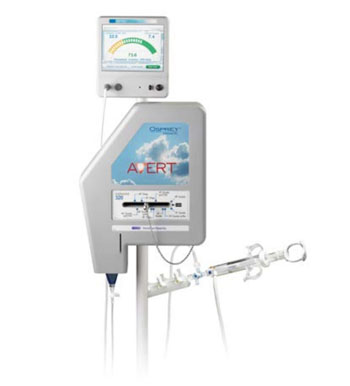Device Significantly Reduces Volume of Dye Needed for CA or PCI Interventions
By MedImaging International staff writers
Posted on 01 Jun 2016
The results of a large, late-breaking, clinical trial have demonstrated a new device that can significantly reduce the volume of radiographic dye required for patients who undergo a coronary angiography, or Percutaneous Coronary Intervention (PCI), but who are at risk of developing acute kidney injury (AKI).Posted on 01 Jun 2016
The device was not able to reduce the sudden deterioration in renal function, called Contrast-Induced AKI (CI-AKI), which can occur following the administration of radiographic dye or Contrast Media Volume (CMV) during interventional cardiac procedures. CI-AKI affects around 20 – 30% of patients, especially those with previous renal impairment, or diabetes, and can cause increased morbidity and mortality.

Image: The AVERT contrast modulation system (Photo courtesy of Osprey Medical).
The results of the study were presented at the Society for Cardiovascular Angiography and Interventions (SCAI) 2016 Scientific Sessions (Orlando, FL, USA). The operator of the AVERT device can control how much dye is injected in the coronary artery, and can dispose of the remaining dye into a reservoir. The prospective, randomized multi-center study took place at 39 sites, and included 578 patients who needed to undergo a coronary angiography and/or PCI, but who were at risk of CI-AKI.
The use of the AVERT device resulted in a relative reduction of 15.5% in CMV in all patients and a relative reduction of 22.8% in CMV for PCI patients. The researchers found no significant differences in CI-AKI, or adverse event rates, in both groups.
Roxana Mehran, MD, FSCAI, lead author of the study, from the Wiener Cardiovascular Institute, Icahn School of Medicine at Mount Sinai Hospital (SMMS; New York, NK, USA), said, “Physicians are extremely careful about the volume of dye they administer to patients; the greater the volume, the more problems a physician can encounter. The bottom line is the AVERT system is safe, easy to use and reduces contrast media volume without sacrificing image quality. While the use of this device did not result in a significant reduction of CI-AKI, there was one exception. A post-hoc analysis showed that in certain groups — patients with a GFR between 40-60 — CI-AKI was significantly reduced. The next step would be to study patients with moderate chronic kidney disease in a prospective randomized trial.”
Related Links:
Society for Cardiovascular Angiography and Interventions
Icahn School of Medicine at Mount Sinai Hospital














